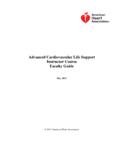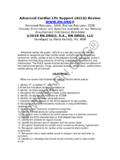Transcription of ACLS Study Guide - ACLS | BLS | CPR | PALS | ECG | …
1 2012 acls Study Guide Critical Care Training Center 12/1/2012 Course Overview This Study Guide is an outline of content that will be taught in the American Heart Association Accredited Advance Cardiac Life Support ( acls ) Course. It is intended to summarize important content, but since all acls content cannot possibly be absorbed in a class given every two Critical Concepts years, it is expected that the student will have the 2010 Updated ECC. Handbook readily available for review as a reference. The student is also High Quality CPR required to have the AHA acls Textbook available for reference and Compress the chest hard and fast Study for more in depth content.
2 Allow complete chest recoil after Evidence Based Updates each compression Minimize interruptions in Approximately every 5 years the AHA updates the guidelines for CPR. compressions ( 10 seconds or less) and Emergency Cardiovascular Care. These updates are necessary to ensure that all AHA courses contain the best information and Switch providers about every 2 minutes to avoid fatigue recommendations that can be supported by current scientific evidence experts from outside the United States and outside the AHA. The Avoid excessive ventilation guidelines were then classified as to the strength of evidence that supports the recommendation.
3 The BLS Survey C A-B. Assess Assessment Technique and Action Tap and shout, Are you all right? . 1 Check Responsiveness Check for absent or abnormal breathing (no breathing or only gasping) by looking at or scanning the chest for movement (about 5 to 10 seconds). Activate the Emergency Activate the emergency response system and get an AED if one is available 2 Response System /get or send someone to activate the emergency response system and get an AED AED or defibrillator Check the carotid pulse for 5 to 10 seconds If no pulse within 10 seconds, start CPR (30.)
4 2) beginning with chest compressions Compress the center of the chest (lower half of the sternum) hard and fast with at least 100 compressions per minute at a depth of at least 2 inches 3 Circulation Allow complete chest recoil after each compression Minimize interruptions in compressions (10 seconds or less). Switch providers about every 2 minutes to avoid fatigue Avoid excessive ventilation If there is a pulse, start rescue breathing at 1 breathe every 5 to 6 seconds (10. to 12 breaths per minute). Check pulse about every 2 minutes.
5 If no pulse, check for a shockable rhythm with an AED/defibrillator as soon 4 Defibrillation as it arrives Provide shocks immediately with CPR, beginning with compressions The acls Survey For unconscious patients in arrest (cardiac or respiratory): Healthcare providers should conduct the acls Survey after completing the BLS. survey. For conscious patients who may need more advanced assessment and management technique: Health providers should conduct the acls Survey first. An important component of this survey is the differential diagnosis, where identification and treatment of the underlying causes may be critical to patient outcome.
6 Effective Resuscitation Team Dynamics Role of the Team Leader is multifaceted. The team leader Organizes the group Monitors individual performance of team members Back up team members Models excellent team behavior Trains and coaches Facilitates understanding Focuses on comprehensive patient care Role of Team Member must be proficient in performing the skills authorized by their scope of practice. Clear about role assignment Prepared to fulfill their role responsibilities Well practiced in resuscitation skills Knowledgeable about the algorithms Committed to success v Closed Loop Communications When communicating with resuscitation team members, the team leader should use closed loop communication by taking these steps The team leader gives a message, order, or assignment to a team member By receiving a clear response and eye contact.
7 The team leader confirms that the team member heard and understood the message The team leader listens for confirmation of task performance from the team before assigning another task. v Clear Messages Clear messages consist of concise communication spoke with distinctive speech in a controlled tone of voice. All healthcare providers should deliver messages and order in a calm and direct manner without yelling or shouting. Unclear communication can lead to unnecessary delays in treatment or to medication errors. v Clear Roles and Responsibilities Every member of the team should know his or her role and responsibilities.
8 Just as different shaped pieces make up a jigsaw puzzle, each team member's role is unique and critical to the effective performance of the team. When roles are unclear, team performance suffers. Signs of unclear roles include: Performing the same task more than once Missing essential tasks Freelancing of team members v Knowing One's Limitations Not only should everyone on the team know his or her own limitations and capabilities, but the team leader should also be aware of them. This allows the team leader to evaluate team resources and call for backup of team members when assistance is needed.
9 V Knowledge Sharing Sharing information is a critical component of effective team performance. Team leaders may become trapped in a specific treatment of diagnostic approach;. this common human error is called a fixation error. v Constructive Intervention During a resuscitation attempt the team leader or a team member may need to intervene if an action that is about to occur may be inappropriate at the time. Although constructive intervention is necessary, it should be tactful. v Reevaluation and Summarizing An essential role of the team leader is monitoring and reevaluating The patient's status Interventions that have been performed Assessment findings v Mutual Respect - The best teams are composed of members who share a mutual respect for each other and work together in a collegial, supportive manner.
10 To have a high-performing team, everyone must abandon ego and respect each other during the resuscitation attempt, regardless of any additional training or experience that the team leader or specific team member may have. System of Care Medical Emergency Teams (METs) and Rapid Response Teams (RRTs). v Many hospitals have implemented the use of METs or RRTs. The purpose of these teams is to improve patient outcomes by identifying and treating early clinical deterioration. In-hospital cardiac arrest is commonly preceded by physiologic changes.







